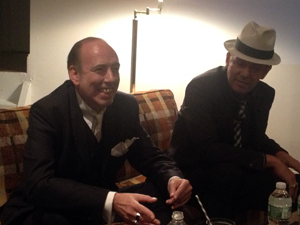The Clash Return to New York City to Launch Box Set, Greatest-Hits Album and Joe Strummer Mural

The Clash were back in New York City last night to launch Sound System, a lavish, boombox-shaped box set; and Hits Back, a greatest-hits collection; and to unveil a new mural of Joe Strummer in the East Village.
The whirlwind evening began at Wallplay on Orchard Street, where videos of the band in its heyday blared across giant screens and black-and-white prints of some of the most iconic images of the band — or of any rock band, for that matter — adorned the walls, courtesy of Rock Paper Photo, the e-commerce fine art photography dealers.
Upstairs, Mick Jones, the band’s guitarist and musical driving force, and Paul Simonon, the band’s bassist and resident artist, held court to a small gathering of friends and press, along with their former press officer and consigliore, Kosmo Vinyl.
Since frontman Joe Strummer’s passing in 2002, the Clash have increasingly attained the legacy status afforded the Beatles and the Rolling Stones and their like, with more and more elaborate reissue packages, films and magazine covers clamoring for aging fans’ dollars. The West London band, whose intense energy at the dawning of punk in 1976 and seemingly effortless evolution over the next seven years make them ripe for constant re-evaluation and revisiting, have become elder statesmen and icons to successive generations.
Sound System is a vast, sprawling, fantastic box set befitting one of the few bands of the late-1970s and early '80s deserving of such attention.
“This is it. This is the final word, in my opinion,” Paul Simonon told me. I hadn’t seen Simonon in nearly 30 years before last night, but the man who so famously smashed his bass on the cover of the Clash’s London Calling album was as charming and understated and generous with his time as ever.

“The design was based on my old boombox,” Simonon said of the fabulous pop objet d’art, a hefty, flip-top carton resembling the ghetto-blaster tape players the band used to lug around on tour. “I photographed my old boombox and did a mock-up and took it in to the record company. They said, ‘Well, that’s very nice but where do the CDs go?’ I chuckled and said, ‘You understand it’s a mock-up, right?’”
Get The Pick Newsletter
All the latest guitar news, interviews, lessons, reviews, deals and more, direct to your inbox!
The faux boombox contains the Clash’s core five albums plus three bonus CDs containing singles, rarities, live cuts and unheard early demos. Plus, there’s a load of memorabilia like badges, posters and stickers, plus a DVD with the band’s videos alongside previously unseen footage shot by Don Letts and Julien Temple and two reprints of the band fanzine Armagideon Times alongside a new issue edited by Simonon, containing rousing memoirs by the Clash and the key members of its inner-circle.
“We wanted to do a miniature Stonehenge,” Jones, who remastered the audio in spectacular form, said, in reference to the classic spoof rockumentary Spinal Tap. “With little slots for the CDs.”
So why do the Clash — famously called “the only band that matters” by anyone in the know back in the day — still matter? One listen to Sound System — or even Hits Back, the new best-of based around Stummer’s handwritten setlist from a 1982 Brixton Academy show — and it’s obvious. The band evolved rapidly and remarkably over the course of its existence, often far ahead of its audience and almost too far ahead of the record company brass and radio programmers who were regularly stymied by the then-latest offering from the band.
“We had no sense of all the change going on in our music or even the momentum we had,” Simonon said. “We were living a 24-hour lifestyle. We lived and breathed it.”
Kosmo Vinyl agreed.
“We took our cue from the Jamaican record industry, where you’d make a record and bam it’d be on the street,” he said. “We subscribed to that immediacy, so to us the amount of output, or the pace at which things moved and changed, didn’t seem unusual.”
Simonon, Jones and Vinyl fittingly spent time with every comer, happily listening to every old story, posing for photographs and signing just about everything put in front of them, just like the old days. Then Jones ventured to musician Jesse Malin’s Lower East Side bar Niagara for the unveiling of a new mural of Strummer by the artist Dr. Revolt.
There old friends and fans clearly too young to have been aware of Strummer during his lifetime mixed and mingled, and Jones met every one with a warm smile and obliging ear for every “your music changed my life” story.
But earlier, as I sat in the front seat of the Cadillac Escalade (“Now this is a proper, gargantuan American car”) there to shepherd Simonon to his next destination, he sat back and said contentedly of the event at Wallplay, “That was nice.”
“Really it was just nice to be in Mick and Paul’s company again,” Kosmo Vinyl told me later. It was.
Jeff Slate is a NYC-based solo singer-songwriter and music journalist. He founded and fronted the band the Badge for 15 years beginning in 1997 and has worked with Pete Townshend, Earl Slick, Carlos Alomar, Steve Holley, Laurence Juber and countless others. He has interviewed and written about everyone from the Beatles and Kiss to Monty Python and rock musicals on Broadway. He is an avid collector of rock and roll books and bootlegs and has an encyclopedic knowledge of all things Dylan and the Beatles. For more information, visit jeffslate.net.









